Systematic Identification of Essential Genes Required for Yeast Cell Wall Integrity: Involvement of the RSC Remodelling Complex
Abstract
1. Introduction
2. Materials and Methods
2.1. Yeast Strains and Media
2.2. Calcofluor White Sensitivity Screening
2.3. Screening for Altered MLP1-GFP Expression Using Flow Cytometry
2.4. Western Blotting Assays
2.5. Quantitative RT-PCR Assays
3. Results and Discussion
3.1. High-Throughput Screening for Essential Genes Required to Cope with Cell Wall Damage
3.2. Identification of Essential Genes Required for the Transcriptional Adaptive Cell Wall Stress Response
3.3. Impact of the RSC Complex on the Expression of CWI Pathway-Dependent Genes
3.4. Identification of Essential Genes Associated with the Constitutive Activation of the Cell Wall Integrity Pathway
Supplementary Materials
Author Contributions
Funding
Institutional Review Board Statement
Informed Consent Statement
Data Availability Statement
Acknowledgments
Conflicts of Interest
References
- Orlean, P. Architecture and biosynthesis of the Saccharomyces cerevisiae cell wall. Genetics 2012, 192, 775–818. [Google Scholar] [CrossRef] [PubMed]
- Cabib, E.; Arroyo, J. How carbohydrates sculpt cells: Chemical control of morphogenesis in the yeast cell wall. Nat. Rev. Microbiol. 2013, 11, 648–655. [Google Scholar] [CrossRef] [PubMed]
- Popolo, L.; Gualtieri, T.; Ragni, E. The yeast cell-wall salvage pathway. Med. Mycol. 2001, 39 (Suppl. 1), 111–121. [Google Scholar] [CrossRef]
- Sanz, A.B.; García, R.; Rodríguez-Peña, J.M.; Arroyo, J. The CWI Pathway: Regulation of the Transcriptional Adaptive Response to Cell Wall Stress in Yeast. J. Fungi 2017, 4, 1. [Google Scholar] [CrossRef] [PubMed]
- Levin, D.E. Regulation of cell wall biogenesis in Saccharomyces cerevisiae: The cell wall integrity signaling pathway. Genetics 2011, 189, 1145–1175. [Google Scholar] [CrossRef] [PubMed]
- Sanz, A.B.; García, R.; Pavon-Verges, M.; Rodriguez-Pena, J.M.; Arroyo, J. Control of Gene Expression via the Yeast CWI Pathway. Int. J. Mol. Sci. 2022, 23, 1791. [Google Scholar] [CrossRef] [PubMed]
- Jung, U.S.; Levin, D.E. Genome-wide analysis of gene expression regulated by the yeast cell wall integrity signalling pathway. Mol. Microbiol. 1999, 34, 1049–1057. [Google Scholar] [CrossRef]
- García, R.; Bermejo, C.; Grau, C.; Pérez, R.; Rodríguez-Peña, J.M.; Francois, J.; Nombela, C.; Arroyo, J. The global transcriptional response to transient cell wall damage in Saccharomyces cerevisiae and its regulation by the cell integrity signaling pathway. J. Biol. Chem. 2004, 279, 15183–15195. [Google Scholar] [CrossRef]
- Sanz, A.B.; García, R.; Rodríguez-Peña, J.M.; Díez-Muñiz, S.; Nombela, C.; Peterson, C.L.; Arroyo, J. Chromatin remodeling by the SWI/SNF complex is essential for transcription mediated by the yeast cell wall integrity MAPK pathway. Mol. Biol. Cell 2012, 23, 2805–2817. [Google Scholar] [CrossRef]
- Lagorce, A.; Hauser, N.C.; Labourdette, D.; Rodríguez, C.; Martin-Yken, H.; Arroyo, J.; Hoheisel, J.D.; Francois, J. Genome-wide analysis of the response to cell wall mutations in the yeast Saccharomyces cerevisiae. J. Biol. Chem. 2003, 278, 20345–20357. [Google Scholar] [CrossRef]
- Arias, P.; Díez-Muñiz, S.; García, R.; Nombela, C.; Rodríguez-Peña, J.M.; Arroyo, J. Genome-wide survey of yeast mutations leading to activation of the yeast cell integrity MAPK pathway: Novel insights into diverse MAPK outcomes. BMC Genom. 2011, 12, 390. [Google Scholar] [CrossRef] [PubMed]
- Sanz, A.B.; García, R.; Rodríguez-Peña, J.M.; Nombela, C.; Arroyo, J. Cooperation between SAGA and SWI/SNF complexes is required for efficient transcriptional responses regulated by the yeast MAPK Slt2. Nucleic Acids Res. 2016, 44, 7159–7172. [Google Scholar] [CrossRef] [PubMed]
- Angus-Hill, M.L.; Schlichter, A.; Roberts, D.; Erdjument-Bromage, H.; Tempst, P.; Cairns, B.R. A Rsc3/Rsc30 zinc cluster dimer reveals novel roles for the chromatin remodeler RSC in gene expression and cell cycle control. Mol. Cell 2001, 7, 741–751. [Google Scholar] [CrossRef]
- Chai, B.; Hsu, J.M.; Du, J.; Laurent, B.C. Yeast RSC function is required for organization of the cellular cytoskeleton via an alternative PKC1 pathway. Genetics 2002, 161, 575–584. [Google Scholar] [CrossRef]
- Wilson, B.; Erdjument-Bromage, H.; Tempst, P.; Cairns, B.R. The RSC chromatin remodeling complex bears an essential fungal-specific protein module with broad functional roles. Genetics 2006, 172, 795–809. [Google Scholar] [CrossRef]
- Wang, S.L.; Cheng, M.Y. The defects in cell wall integrity and G2-M transition of the htl1 mutant are interconnected. Yeast 2012, 29, 45–57. [Google Scholar] [CrossRef]
- Rando, O.J.; Winston, F. Chromatin and transcription in yeast. Genetics 2012, 190, 351–387. [Google Scholar] [CrossRef]
- Giaever, G.; Chu, A.M.; Ni, L.; Connelly, C.; Riles, L.; Veronneau, S.; Dow, S.; Lucau-Danila, A.; Anderson, K.; Andre, B.; et al. Functional profiling of the Saccharomyces cerevisiae genome. Nature 2002, 418, 387–391. [Google Scholar] [CrossRef]
- Page, N.; Gerard-Vincent, M.; Menard, P.; Beaulieu, M.; Azuma, M.; Dijkgraaf, G.J.; Li, H.; Marcoux, J.; Nguyen, T.; Dowse, T.; et al. A Saccharomyces cerevisiae genome-wide mutant screen for altered sensitivity to K1 killer toxin. Genetics 2003, 163, 875–894. [Google Scholar] [CrossRef]
- Serviene, E.; Luksa, J.; Orentaite, I.; Lafontaine, D.L.; Urbonavicius, J. Screening the budding yeast genome reveals unique factors affecting K2 toxin susceptibility. PLoS ONE 2012, 7, e50779. [Google Scholar] [CrossRef]
- Rodríguez-Peña, J.M.; Díez-Muñiz, S.; Bermejo, C.; Nombela, C.; Arroyo, J. Activation of the yeast cell wall integrity MAPK pathway by zymolyase depends on protease and glucanase activities and requires the mucin-like protein Hkr1 but not Msb2. FEBS Lett. 2013, 587, 3675–3680. [Google Scholar] [CrossRef] [PubMed]
- García, R.; Botet, J.; Rodríguez-Peña, J.M.; Bermejo, C.; Ribas, J.C.; Revuelta, J.L.; Nombela, C.; Arroyo, J. Genomic profiling of fungal cell wall-interfering compounds: Identification of a common gene signature. BMC Genom. 2015, 16, 683. [Google Scholar] [CrossRef] [PubMed]
- Ando, A.; Nakamura, T.; Murata, Y.; Takagi, H.; Shima, J. Identification and classification of genes required for tolerance to freeze-thaw stress revealed by genome-wide screening of Saccharomyces cerevisiae deletion strains. FEMS Yeast Res. 2007, 7, 244–253. [Google Scholar] [CrossRef] [PubMed]
- Auesukaree, C.; Damnernsawad, A.; Kruatrachue, M.; Pokethitiyook, P.; Boonchird, C.; Kaneko, Y.; Harashima, S. Genome-wide identification of genes involved in tolerance to various environmental stresses in Saccharomyces cerevisiae. J. Appl. Genet. 2009, 50, 301–310. [Google Scholar] [CrossRef] [PubMed]
- Rodríguez-Peña, J.M.; Díez-Muñiz, S.; Nombela, C.; Arroyo, J. A yeast strain biosensor to detect cell wall-perturbing agents. J. Biotechnol. 2008, 133, 311–317. [Google Scholar] [CrossRef]
- Giaever, G.; Nislow, C. The yeast deletion collection: A decade of functional genomics. Genetics 2014, 197, 451–465. [Google Scholar] [CrossRef]
- De Groot, P.W.; Ruiz, C.; Vázquez de Aldana, C.R.; Duenas, E.; Cid, V.J.; Del Rey, F.; Rodríguez-Peña, J.M.; Pérez, P.; Andel, A.; Caubín, J.; et al. A genomic approach for the identification and clasification of genes involved in cell wall formation and its regulation in Saccharomyces cerevisiae. Comp. Funct. Genom. 2001, 2, 124–142. [Google Scholar] [CrossRef]
- Norman, K.L.; Kumar, A. Mutant power: Using mutant allele collections for yeast functional genomics. Brief Funct. Genom. 2016, 15, 75–84. [Google Scholar] [CrossRef]
- Mnaimneh, S.; Davierwala, A.P.; Haynes, J.; Moffat, J.; Peng, W.T.; Zhang, W.; Yang, X.; Pootoolal, J.; Chua, G.; Lopez, A.; et al. Exploration of essential gene functions via titratable promoter alleles. Cell 2004, 118, 31–44. [Google Scholar] [CrossRef]
- Cappell, S.D.; Baker, R.; Skowyra, D.; Dohlman, H.G. Systematic analysis of essential genes reveals important regulators of G protein signaling. Mol. Cell 2010, 38, 746–757. [Google Scholar] [CrossRef]
- Tatjer, L.; Sacristan-Reviriego, A.; Casado, C.; Gonzalez, A.; Rodriguez-Porrata, B.; Palacios, L.; Canadell, D.; Serra-Cardona, A.; Martin, H.; Molina, M.; et al. Wide-Ranging Effects of the Yeast Ptc1 Protein Phosphatase Acting Through the MAPK Kinase Mkk1. Genetics 2016, 202, 141–156. [Google Scholar] [CrossRef] [PubMed]
- Bermejo, C.; Rodríguez, E.; García, R.; Rodríguez-Peña, J.M.; Rodríguez de la Concepcion, M.L.; Rivas, C.; Arias, P.; Nombela, C.; Posas, F.; Arroyo, J. The sequential activation of the yeast HOG and SLT2 pathways is required for cell survival to cell wall stress. Mol. Biol. Cell. 2008, 19, 1113–1124. [Google Scholar] [CrossRef]
- Livak, K.J.; Schmittgen, T.D. Analysis of relative gene expression data using real-time quantitative PCR and the 2(-Delta Delta C(T)) Method. Methods 2001, 25, 402–408. [Google Scholar] [CrossRef] [PubMed]
- Zhao, F.; Li, J.; Lin, K.; Chen, H.; Lin, Y.; Zheng, S.; Liang, S.; Han, S. Genome-wide screening of Saccharomyces cerevisiae deletion mutants reveals cellular processes required for tolerance to the cell wall antagonist calcofluor white. Biochem. Biophys. Res. Commun. 2019, 518, 1–6. [Google Scholar] [CrossRef] [PubMed]
- Chen, P.; Wang, D.; Chen, H.; Zhou, Z.; He, X. The nonessentiality of essential genes in yeast provides therapeutic insights into a human disease. Genome Res. 2016, 26, 1355–1362. [Google Scholar] [CrossRef] [PubMed]
- García, R.; Rodríguez-Peña, J.M.; Bermejo, C.; Nombela, C.; Arroyo, J. The high osmotic response and cell wall integrity pathways cooperate to regulate transcriptional responses to zymolyase-induced cell wall stress in Saccharomyces cerevisiae. J. Biol. Chem. 2009, 284, 10901–10911. [Google Scholar] [CrossRef]
- García, R.; Bravo, E.; Díez-Muñiz, S.; Nombela, C.; Rodríguez-Peña, J.M.; Arroyo, J. A novel connection between the Cell Wall Integrity and the PKA pathways regulates cell wall stress response in yeast. Sci. Rep. 2017, 7, 5703. [Google Scholar] [CrossRef]
- Montefusco, D.J.; Matmati, N.; Hannun, Y.A. The yeast sphingolipid signaling landscape. Chem. Phys. Lipids 2014, 177, 26–40. [Google Scholar] [CrossRef]
- Hahn, J.S.; Neef, D.W.; Thiele, D.J. A stress regulatory network for co-ordinated activation of proteasome expression mediated by yeast heat shock transcription factor. Mol. Microbiol. 2006, 60, 240–251. [Google Scholar] [CrossRef]
- Ma, M.; Liu, Z.L. Comparative transcriptome profiling analyses during the lag phase uncover YAP1, PDR1, PDR3, RPN4, and HSF1 as key regulatory genes in genomic adaptation to the lignocellulose derived inhibitor HMF for Saccharomyces cerevisiae. BMC Genom. 2010, 11, 660. [Google Scholar] [CrossRef]
- Rousseau, A.; Bertolotti, A. An evolutionarily conserved pathway controls proteasome homeostasis. Nature 2016, 536, 184–189. [Google Scholar] [CrossRef] [PubMed]
- Livneh, I.; Cohen-Kaplan, V.; Cohen-Rosenzweig, C.; Avni, N.; Ciechanover, A. The life cycle of the 26S proteasome: From birth, through regulation and function, and onto its death. Cell Res. 2016, 26, 869–885. [Google Scholar] [CrossRef]
- Zander, G.; Hackmann, A.; Bender, L.; Becker, D.; Lingner, T.; Salinas, G.; Krebber, H. mRNA quality control is bypassed for immediate export of stress-responsive transcripts. Nature 2016, 540, 593–596. [Google Scholar] [CrossRef] [PubMed]
- Erkina, T.Y.; Zou, Y.; Freeling, S.; Vorobyev, V.I.; Erkine, A.M. Functional interplay between chromatin remodeling complexes RSC, SWI/SNF and ISWI in regulation of yeast heat shock genes. Nucleic Acids Res. 2010, 38, 1441–1449. [Google Scholar] [CrossRef]
- Sahu, R.K.; Singh, S.; Tomar, R.S. The ATP-dependent SWI/SNF and RSC chromatin remodelers cooperatively induce unfolded protein response genes during endoplasmic reticulum stress. Biochim. Biophys. Acta Gene Regul. Mech. 2021, 1864, 194748. [Google Scholar] [CrossRef] [PubMed]
- Ye, Y.; Wu, H.; Chen, K.; Clapier, C.R.; Verma, N.; Zhang, W.; Deng, H.; Cairns, B.R.; Gao, N.; Chen, Z. Structure of the RSC complex bound to the nucleosome. Science 2019, 366, 838–843. [Google Scholar] [CrossRef]
- Lorch, Y.; Kornberg, R.D. Chromatin-remodeling for transcription. Q. Rev. Biophys. 2017, 50, e5. [Google Scholar] [CrossRef]
- Biernat, E.; Kinney, J.; Dunlap, K.; Rizza, C.; Govind, C.K. The RSC complex remodels nucleosomes in transcribed coding sequences and promotes transcription in Saccharomyces cerevisiae. Genetics 2021, 217, iyab021. [Google Scholar] [CrossRef]
- Sing, T.L.; Hung, M.P.; Ohnuki, S.; Suzuki, G.; San Luis, B.J.; McClain, M.; Unruh, J.R.; Yu, Z.; Ou, J.; Marshall-Sheppard, J.; et al. The budding yeast RSC complex maintains ploidy by promoting spindle pole body insertion. J. Cell Biol. 2018, 217, 2445–2462. [Google Scholar] [CrossRef]
- Kasten, M.; Szerlong, H.; Erdjument-Bromage, H.; Tempst, P.; Werner, M.; Cairns, B.R. Tandem bromodomains in the chromatin remodeler RSC recognize acetylated histone H3 Lys14. EMBO J. 2004, 23, 1348–1359. [Google Scholar] [CrossRef]
- Conde, R.; Cueva, R.; Larriba, G. Rsc14-controlled expression of MNN6, MNN4 and MNN1 regulates mannosylphosphorylation of Saccharomyces cerevisiae cell wall mannoproteins. FEMS Yeast Res. 2007, 7, 1248–1255. [Google Scholar] [CrossRef] [PubMed][Green Version]
- Damelin, M.; Simon, I.; Moy, T.I.; Wilson, B.; Komili, S.; Tempst, P.; Roth, F.P.; Young, R.A.; Cairns, B.R.; Silver, P.A. The genome-wide localization of Rsc9, a component of the RSC chromatin-remodeling complex, changes in response to stress. Mol. Cell 2002, 9, 563–573. [Google Scholar] [CrossRef]
- Mas, G.; de Nadal, E.; Dechant, R.; Rodríguez de la Concepcion, M.L.; Logie, C.; Jimeno-Gonzalez, S.; Chavez, S.; Ammerer, G.; Posas, F. Recruitment of a chromatin remodelling complex by the Hog1 MAP kinase to stress genes. EMBO J. 2009, 28, 326–336. [Google Scholar] [CrossRef] [PubMed]
- Garcia, R.; Itto-Nakama, K.; Rodriguez-Pena, J.M.; Chen, X.; Sanz, A.B.; de Lorenzo, A.; Pavon-Verges, M.; Kubo, K.; Ohnuki, S.; Nombela, C.; et al. Poacic acid, a beta-1,3-glucan-binding antifungal agent, inhibits cell-wall remodeling and activates transcriptional responses regulated by the cell-wall integrity and high-osmolarity glycerol pathways in yeast. FASEB J. 2021, 35, e21778. [Google Scholar] [CrossRef] [PubMed]
- Rodríguez-Peña, J.M.; Pérez-Diaz, R.M.; Alvarez, S.; Bermejo, C.; García, R.; Santiago, C.; Nombela, C.; Arroyo, J. The ‘yeast cell wall chip’—A tool to analyse the regulation of cell wall biogenesis in Saccharomyces cerevisiae. Microbiology 2005, 151, 2241–2249. [Google Scholar] [CrossRef]
- Muñiz, M.; Riezman, H. Trafficking of glycosylphosphatidylinositol anchored proteins from the endoplasmic reticulum to the cell surface. J. Lipid Res. 2016, 57, 352–360. [Google Scholar] [CrossRef]
- Pittet, M.; Conzelmann, A. Biosynthesis and function of GPI proteins in the yeast Saccharomyces cerevisiae. Biochim. Biophys. Acta 2007, 1771, 405–420. [Google Scholar] [CrossRef]
- Bowman, S.M.; Free, S.J. The structure and synthesis of the fungal cell wall. Bioessays 2006, 28, 799–808. [Google Scholar] [CrossRef]
- Mishra, M.; Huang, J.; Balasubramanian, M.K. The yeast actin cytoskeleton. FEMS Microbiol. Rev. 2014, 38, 213–227. [Google Scholar] [CrossRef]
- Curwin, A.J.; von Blume, J.; Malhotra, V. Cofilin-mediated sorting and export of specific cargo from the Golgi apparatus in yeast. Mol. Biol. Cell 2012, 23, 2327–2338. [Google Scholar] [CrossRef]
- Li, H.; Page, N.; Bussey, H. Actin patch assembly proteins Las17p and Sla1p restrict cell wall growth to daughter cells and interact with cis-Golgi protein Kre6p. Yeast 2002, 19, 1097–1112. [Google Scholar] [CrossRef] [PubMed]
- Sukegawa, Y.; Negishi, T.; Kikuchi, Y.; Ishii, K.; Imanari, M.; Ghanegolmohammadi, F.; Nogami, S.; Ohya, Y. Genetic dissection of the signaling pathway required for the cell wall integrity checkpoint. J. Cell Sci. 2018, 131, jcs219063. [Google Scholar] [CrossRef] [PubMed]
- Mahfouz, H.; Ragnini-Wilson, A.; Venditti, R.; De Matteis, M.A.; Wilson, C. Mutational analysis of the yeast TRAPP subunit Trs20p identifies roles in endocytic recycling and sporulation. PLoS ONE 2012, 7, e41408. [Google Scholar] [CrossRef] [PubMed][Green Version]
- Guo, Q.; Duan, Y.; Meng, N.; Liu, Y.; Luo, G. The N-terminus of Sec3 is required for cell wall integrity in yeast. Biochimie 2020, 177, 30–39. [Google Scholar] [CrossRef]
- Suda, Y.; Tachikawa, H.; Inoue, I.; Kurita, T.; Saito, C.; Kurokawa, K.; Nakano, A.; Irie, K. Activation of Rab GTPase Sec4 by its GEF Sec2 is required for prospore membrane formation during sporulation in yeast Saccharomyces cerevisiae. FEMS Yeast Res. 2018, 18, fox095. [Google Scholar] [CrossRef]
- Bialek-Wyrzykowska, U.; Bauer, B.E.; Wagner, W.; Kohlwein, S.D.; Schweyen, R.J.; Ragnini, A. Low levels of Ypt protein prenylation cause vesicle polarization defects and thermosensitive growth that can be suppressed by genes involved in cell wall maintenance. Mol. Microbiol. 2000, 35, 1295–1311. [Google Scholar] [CrossRef]
- Orlowski, J.; Machula, K.; Janik, A.; Zdebska, E.; Palamarczyk, G. Dissecting the role of dolichol in cell wall assembly in the yeast mutants impaired in early glycosylation reactions. Yeast 2007, 24, 239–252. [Google Scholar] [CrossRef][Green Version]
- Bickle, M.; Delley, P.A.; Schmidt, A.; Hall, M.N. Cell wall integrity modulates RHO1 activity via the exchange factor ROM2. EMBO J. 1998, 17, 2235–2245. [Google Scholar] [CrossRef]
- Machi, K.; Azuma, M.; Igarashi, K.; Matsumoto, T.; Fukuda, H.; Kondo, A.; Ooshima, H. Rot1p of Saccharomyces cerevisiae is a putative membrane protein required for normal levels of the cell wall 1,6-beta-glucan. Microbiology 2004, 150, 3163–3173. [Google Scholar] [CrossRef]
- Absmanner, B.; Schmeiser, V.; Kampf, M.; Lehle, L. Biochemical characterization, membrane association and identification of amino acids essential for the function of Alg11 from Saccharomyces cerevisiae, an alpha1,2-mannosyltransferase catalysing two sequential glycosylation steps in the formation of the lipid-linked core oligosaccharide. Biochem. J. 2010, 426, 205–217. [Google Scholar] [CrossRef][Green Version]
- Rodríguez-Peña, J.M.; Rodríguez, C.; Alvarez, A.; Nombela, C.; Arroyo, J. Mechanisms for targeting of the Saccharomyces cerevisiae GPI-anchored cell wall protein Crh2p to polarised growth sites. J. Cell Sci. 2002, 115, 2549–2558. [Google Scholar] [CrossRef] [PubMed]
- Rodríguez-Pachon, J.M.; Martin, H.; North, G.; Rotger, R.; Nombela, C.; Molina, M. A novel connection between the yeast Cdc42 GTPase and the Slt2-mediated cell integrity pathway identified through the effect of secreted Salmonella GTPase modulators. J. Biol. Chem. 2002, 277, 27094–27102. [Google Scholar] [CrossRef] [PubMed]
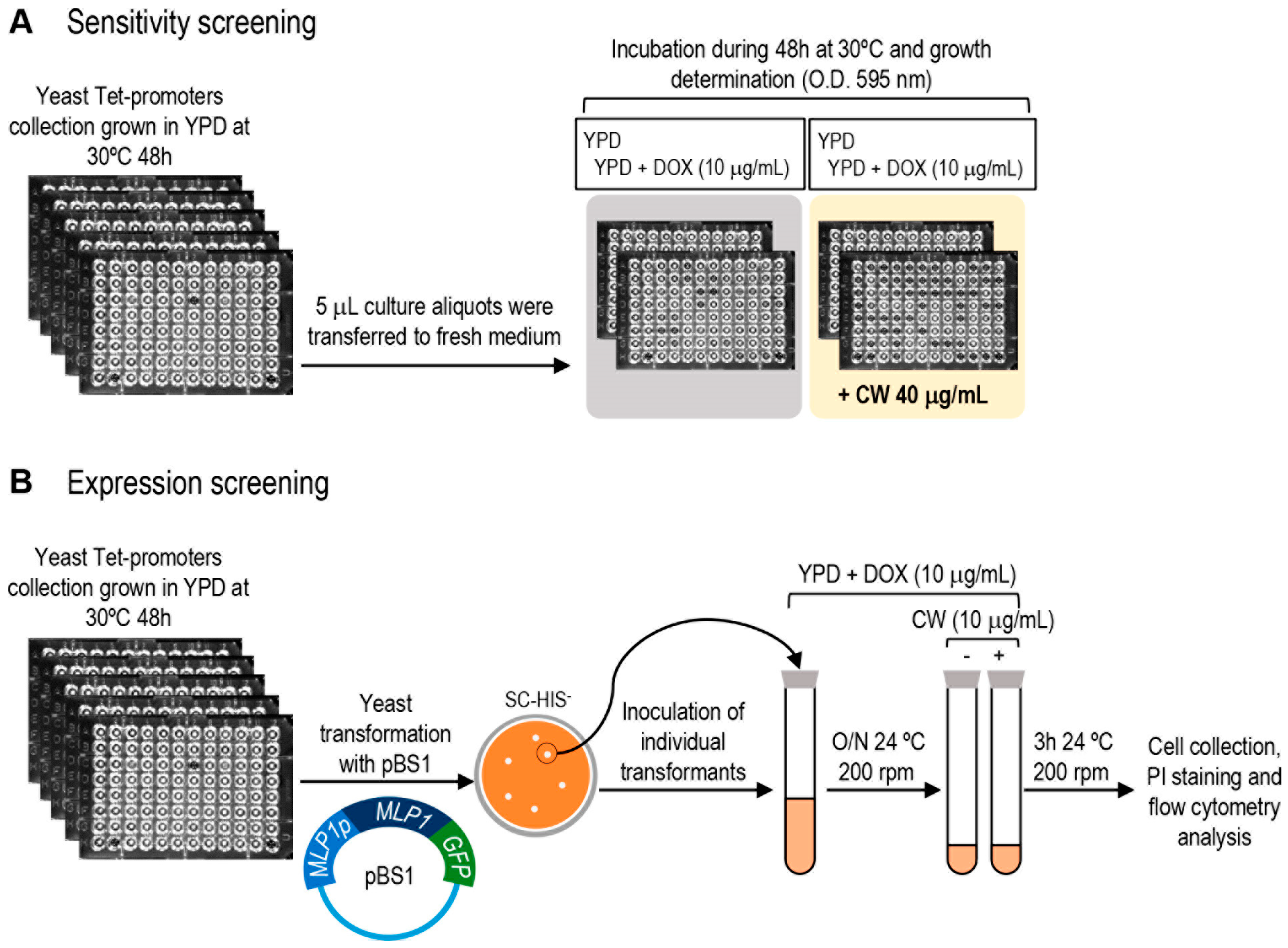
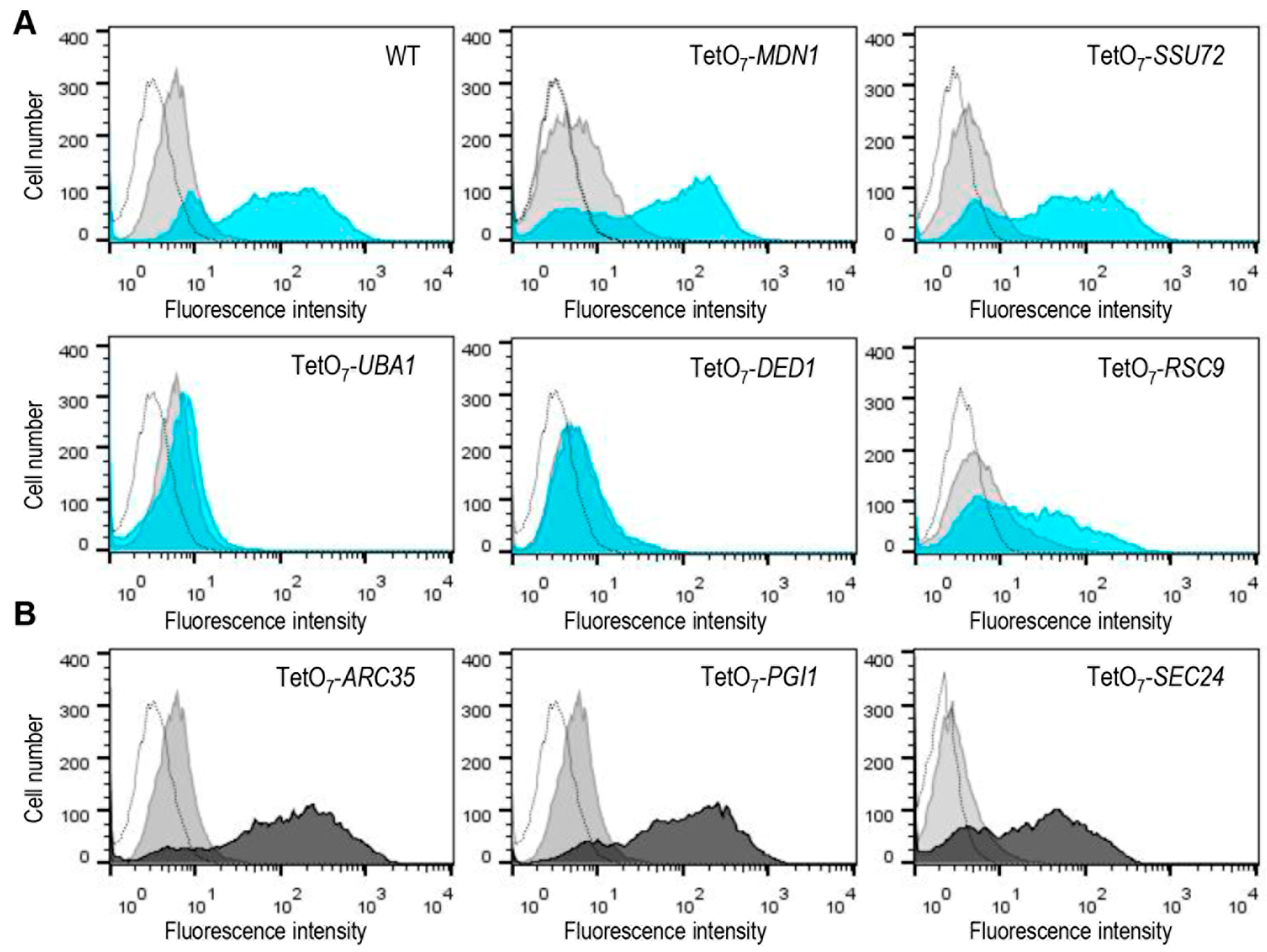
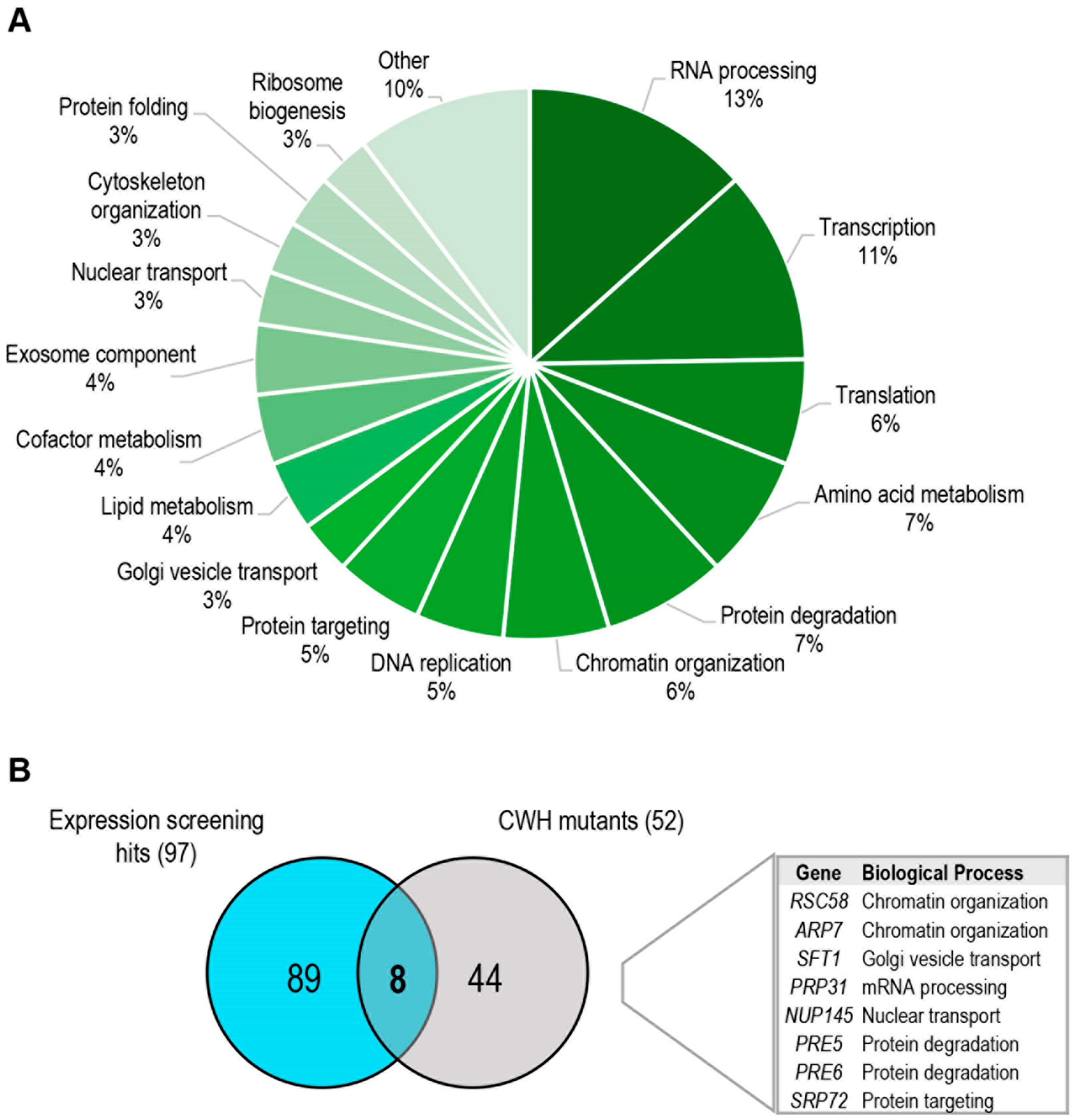
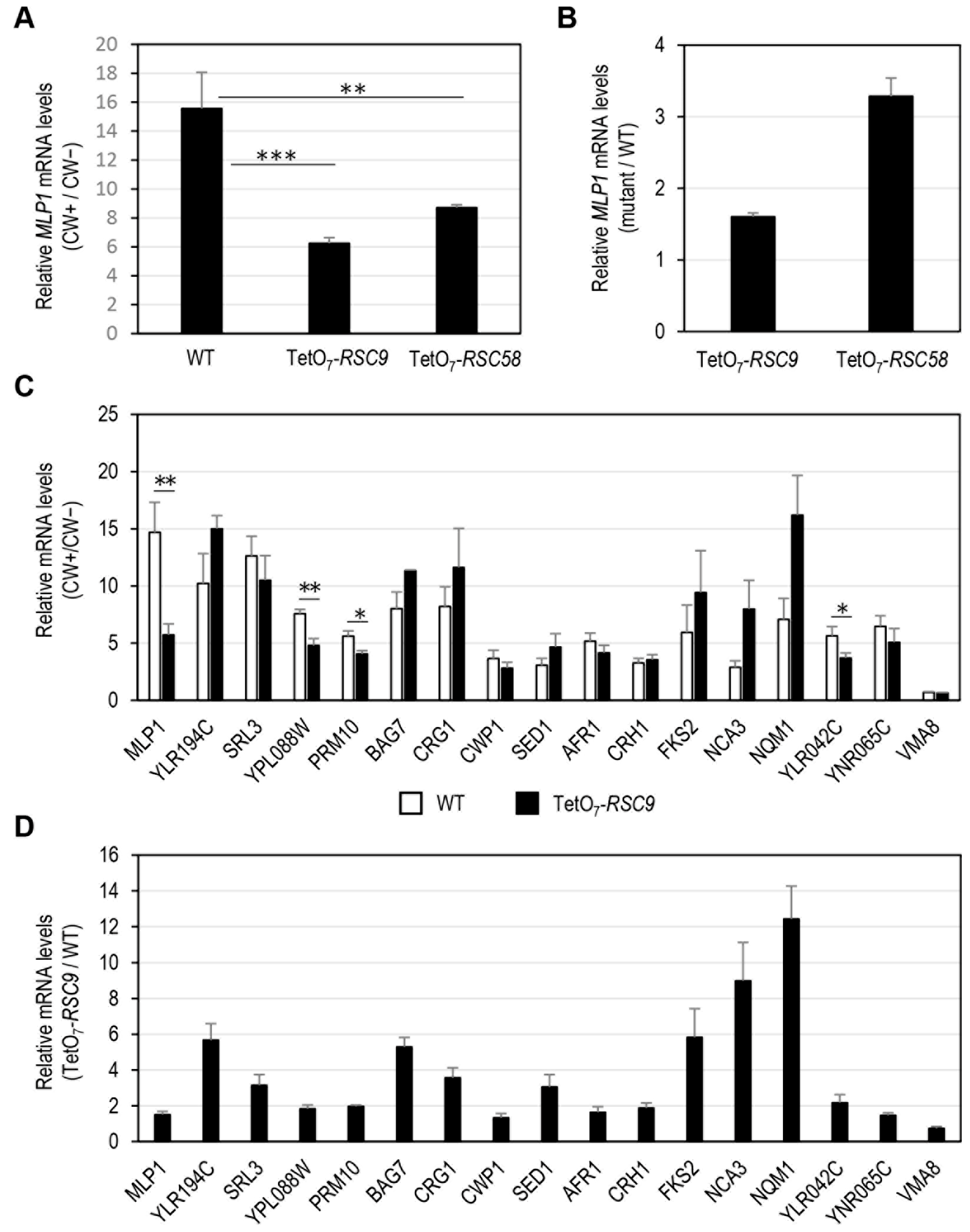
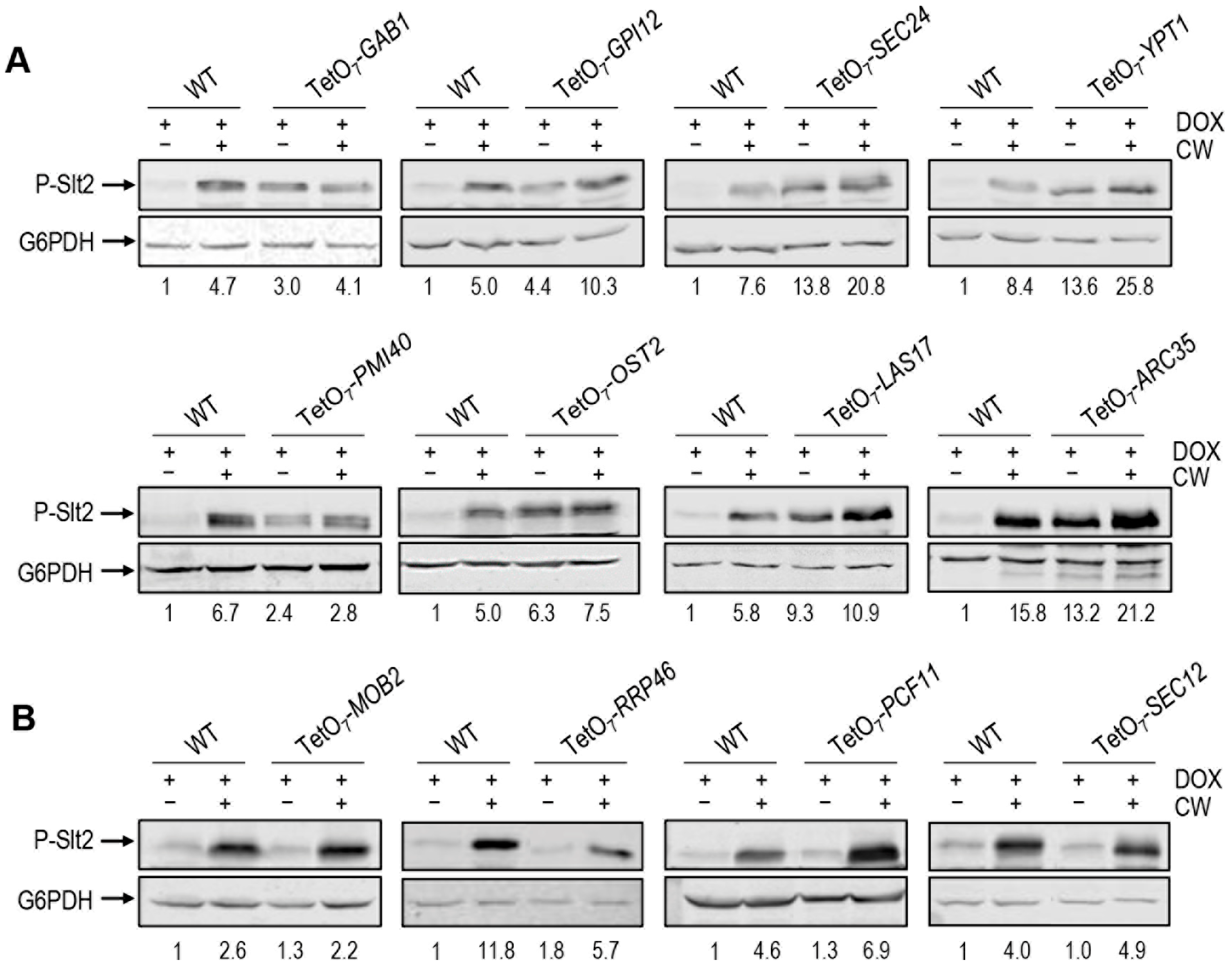
| Gene | CW Sensitivity | Biological Process | Gene | CW Sensitivity | Biological Process |
|---|---|---|---|---|---|
| CDC20 | 0.10 | Cell cycle | CFT1 | 0.14 | mRNA processing |
| CKS1 | 0.09 | Cell cycle | DCP2 | 0.14 | mRNA processing |
| GUK1 | 0.16 | Cell wall | PRP31 | 0.16 | mRNA processing |
| ARP7 | 0.19 | Chromatin organization | NUP145 | 0.18 | Nuclear transport |
| RSC58 | 0.20 | Chromatin organization | PRE5 | 0.18 | Protein degradation |
| RSC6 | 0.08 | Chromatin organization | PRE6 | 0.18 | Protein degradation |
| RSC8 | 0.20 | Chromatin organization | RPT6 | 0.17 | Protein degradation |
| SPT16 | 0.20 | Chromatin organization | OST2 | 0.07 | Protein glycosylation |
| STH1 | 0.12 | Chromatin organization | RFT1 | 0.10 | Protein glycosylation |
| TAF10 | 0.15 | Chromatin organization | ROT1 | 0.11 | Protein glycosylation |
| TAF5 | 0.20 | Chromatin organization | SWP1 | 0.18 | Protein glycosylation |
| ARC40 | 0.18 | Cytoskeleton organization | VRG4 | 0.06 | Protein glycosylation |
| PFY1 | 0.06 | Cytoskeleton organization | SRP68 | 0.19 | Protein targeting |
| MCM7 | 0.18 | DNA replication | SRP72 | 0.13 | Protein targeting |
| SLD5 | 0.17 | DNA replication | YPP1 | 0.17 | Protein targeting |
| BET3 | 0.13 | Golgi vesicle transport | BRX1 | 0.15 | rRNA processing |
| DOP1 | 0.15 | Golgi vesicle transport | DBP9 | 0.20 | rRNA processing |
| SEC14 | 0.14 | Golgi vesicle transport | EBP2 | 0.17 | rRNA processing |
| SEC18 | 0.12 | Golgi vesicle transport | FAP7 | 0.04 | rRNA processing |
| SEC2 | 0.11 | Golgi vesicle transport | FCF1 | 0.17 | rRNA processing |
| SFT1 | 0.09 | Golgi vesicle transport | SPB1 | 0.19 | rRNA processing |
| TIP20 | 0.14 | Golgi vesicle transport | NOP2 | 0.15 | rRNA processing |
| YIP1 | 0.16 | Golgi vesicle transport | NOP15 | 0.19 | rRNA processing |
| GAB1 | 0.12 | GPI biosynthesis | MOT1 | 0.18 | Transcription |
| MCD4 | 0.18 | GPI biosynthesis | RPL18A | 0.17 | Translation |
| PHS1 | 0.10 | Lipid metabolism | TIF35 | 0.14 | Translation |
| Gene | Mlp1-GFP Ratio | CW Sensitivity | Biological Process | Cell Wall Association |
|---|---|---|---|---|
| PGI1 | 5.23 | 0.22 | Carbohydrate metabolism | |
| CDC12 | 5.29 | 0.30 | Cell cycle | |
| MET30 | 4.84 | 0.93 | Cell cycle | |
| MTW1 | 4.65 | N.M. | Chromosome segregation | |
| SPC34 | 7.09 | 1.41 | Chromosome segregation | |
| ARP2 | 7.63 | 1.48 | Cytoskeleton organization | |
| COF1 | 7.17 | 0.73 | Cytoskeleton organization | [60] |
| ARC35 | 6.29 | 0.37 | Cytoskeleton organization | |
| LAS17 | 3.57 | 0.87 | Cytoskeleton organization | [61,62] |
| TRS20 | 3.01 | 0.38 | Golgi vesicle transport | [63] |
| SEC5 | 3.95 | 0.44 | Golgi vesicle transport | |
| SEC3 | 5.07 | 0.24 | Golgi vesicle transport | [64] |
| SEC4 | 4.94 | 0.27 | Golgi vesicle transport | [65] |
| YPT1 | 3.78 | 0.41 | Golgi vesicle transport | [66] |
| SEC15 | 6.93 | N.M. | Golgi vesicle transport | |
| SEC24 | 3.64 | 0.32 | Golgi vesicle transport | |
| SEC10 | 9.46 | 0.50 | Golgi vesicle transport | |
| SAR1 | 3.27 | N.M. | Golgi vesicle transport | |
| GPI17 | 3.44 | 0.21 | GPI biosynthesis | |
| GPI16 | 6.27 | 0.51 | GPI biosynthesis | |
| GAB1 | 6.47 | 0.12 | GPI biosynthesis | |
| GPI12 | 3.03 | 0.39 | GPI biosynthesis | |
| PGA1 | 12.99 | N.M. | GPI biosynthesis | |
| RER2 | 3.28 | 0.27 | Lipid metabolism | [67] |
| ERO1 | 4.62 | N.M. | Protein folding | |
| ROT1 | 7.97 | 0.11 | Protein folding | [68,69] |
| RFT1 | 4.39 | 0.10 | Protein glycosylation | |
| ALG14 | 5.72 | 0.23 | Protein glycosylation | |
| WBP1 | 5.95 | 0.42 | Protein glycosylation | |
| PMI40 | 3.04 | 0.91 | Protein glycosylation | |
| SEC53 | 3.14 | 0.44 | Protein glycosylation | |
| VRG4 | 2.96 | 0.06 | Protein glycosylation | |
| SWP1 | 3.36 | 0.18 | Protein glycosylation | |
| ALG11 | 3.07 | 0.21 | Protein glycosylation | [70] |
| OST2 | 5.74 | 0.07 | Protein glycosylation | |
| DPM1 | 3.34 | 0.46 | Protein glycosylation | [67] |
| SEC63 | 4.22 | 0.82 | Protein targeting | |
| CDC42 | 9.02 | 2.19 | Signaling | [71,72] |
| RPA190 | 3.60 | 0.33 | Transcription from RNA pol I | |
| MOT1 | 3.82 | 0.18 | Transcription from RNA pol II | |
| YNL171C | 5.45 | 1.23 | Unknown |
Publisher’s Note: MDPI stays neutral with regard to jurisdictional claims in published maps and institutional affiliations. |
© 2022 by the authors. Licensee MDPI, Basel, Switzerland. This article is an open access article distributed under the terms and conditions of the Creative Commons Attribution (CC BY) license (https://creativecommons.org/licenses/by/4.0/).
Share and Cite
Sanz, A.B.; Díez-Muñiz, S.; Moya, J.; Petryk, Y.; Nombela, C.; Rodríguez-Peña, J.M.; Arroyo, J. Systematic Identification of Essential Genes Required for Yeast Cell Wall Integrity: Involvement of the RSC Remodelling Complex. J. Fungi 2022, 8, 718. https://doi.org/10.3390/jof8070718
Sanz AB, Díez-Muñiz S, Moya J, Petryk Y, Nombela C, Rodríguez-Peña JM, Arroyo J. Systematic Identification of Essential Genes Required for Yeast Cell Wall Integrity: Involvement of the RSC Remodelling Complex. Journal of Fungi. 2022; 8(7):718. https://doi.org/10.3390/jof8070718
Chicago/Turabian StyleSanz, Ana Belén, Sonia Díez-Muñiz, Jennifer Moya, Yuliya Petryk, César Nombela, José M. Rodríguez-Peña, and Javier Arroyo. 2022. "Systematic Identification of Essential Genes Required for Yeast Cell Wall Integrity: Involvement of the RSC Remodelling Complex" Journal of Fungi 8, no. 7: 718. https://doi.org/10.3390/jof8070718
APA StyleSanz, A. B., Díez-Muñiz, S., Moya, J., Petryk, Y., Nombela, C., Rodríguez-Peña, J. M., & Arroyo, J. (2022). Systematic Identification of Essential Genes Required for Yeast Cell Wall Integrity: Involvement of the RSC Remodelling Complex. Journal of Fungi, 8(7), 718. https://doi.org/10.3390/jof8070718







